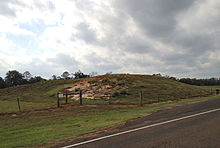Caddo Mounds State Historic Site (41CE19) (also known as the George C. Davis Site) is an
archaeological site in
Cherokee County, Texas used by peoples of the
Caddoan Mississippian culture and is composed of a prehistoric village and ceremonial center. The site is located on the original
El Camino Real de los Tejas trail, dating before European exploration. The site has two
platform mounds and one
burial mound. Archaeologists believe the site was founded in approximately 800 CE, with most major construction taking place between 1100 and 1300 CE. It is located 6 miles (9.7 km) west of
Alto, Texas on
Texas State Highway 21 near its intersection with
U.S. Route 69 in the
Piney Woods region of east Texas. Operated by the
Texas Historical Commission, the museum exhibits approximately 200 artifacts, including pottery, tools, and weapons. Visitors can walk the 0.7 miles (1.1 km) self-guided interpretive trail to see the Caddo’s burial, low temple, and ceremonial mounds. An additional trail along the El Camino Real is also available.
Description[edit]

Map of Caddoan Mississippian sites

Mound A at the Caddo Mounds State Historic Site
The site began with the founding of a permanent village by the
Hasinai,
[1] who moved into the region from the
Red River area to the northeast, in roughly 850 to 900 CE.
[2] The region possessed ideal qualities for the establishment of a village: good soil, abundant food resources, and a permanent water source that flowed into the Neches River.
[3] What eventually became the largest mound, Mound A, was begun at this time. It is at the southern edge of the site, and was surrounded by about 40 houses. In 1100 CE a new mound was begun near the center of the site, Mound B, and would eventually measure roughly 175 feet (55 meters) north-south and 115 feet (35 meters) east-west. Mound C, the northernmost mound of the three, was used as a burial mound, not for elite residences or temples like the other two.
[4] The site was the southwestern-most ceremonial mound center of all the great
mound building cultures of North America.
[4]
The settlement was abandoned in the 13th century, when the elite ruling class dissipated after the outlying hamlets became more self-sufficient and grew less dependent on the site for religious and political matters. The Caddo culture that remained was similar to the earlier culture in many ways, but lacked much of its hierarchical structure and exotic material wealth.
[3] By the time Europeans arrived in the area in the 18th century, the Caddo groups in the area lived in small villages and hamlets, spread across the local landscape. They had long since stopped building mounds, and their former hierarchical social and political organization had become much less centralized.
[2]
Modern excavations[edit]
The earliest recorded mention of the mounds was in 1779 by Athanase de Mézières who traveled from
Louisiana to
San Antonio in the employ of the Spanish government.
James Edwin Pearce was the first professional archeologist to record the site for the
Bureau of Ethnology in 1919. In 1933 archeologist
E. B. Sayles concluded that the site was a Caddo mound center after conducting surface collection of artifacts at the location.
[2] The first scientific excavations were conducted from 1939 to 1941 by
H. Perry Newell, a
University of Texas archeologist with the
Work Projects Administration. When Newell died, archeologist
Alex D. Krieger took over investigations at the site, and concluded that it had been a major Caddo site. Further excavations in the 1960s and early 1970s by
Dee Ann Story pinpointed the timeline of the site to 780 and 1260 CE.
[2]
See also[edit]
References[edit]
External links[edit]
 | Wikimedia Commons has media related to Caddo. |





No comments:
Post a Comment